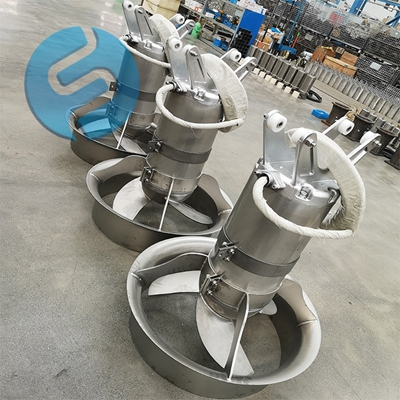The speed of the mixer has a significant impact on the treatment effect, which is reflected in the following aspects:
First, affect the mixing efficiency and uniformity
1. Mixing efficiency: The rapid speed can improve the mixing efficiency, so that the mixing process is relatively full in a short time. On the contrary, the slow speed will lead to a longer mixing process, but in some cases (such as when mixing viscous materials), slow mixing can better ensure the uniformity of mixing and avoid material damage due to too fast mixing.
2. Mixing uniformity: The appropriate speed can make the material evenly mixed, which is particularly important for sewage treatment and other processes. However, too high a speed may cause uneven mixing, affecting the treatment effect.

Second, affect the treatment process and results
1. Promote chemical reaction: In the sewage treatment stage that requires chemical reaction (such as flocculation, disinfection, etc.), the speed of the mixer directly affects the reaction rate and effect. Proper rotation speed can promote the full reaction of chemicals with pollutants in sewage and improve treatment efficiency.
2. Prevent sludge deposition: Continuous or regular stirring of the mixer can prevent sludge deposition at the bottom of the pool and maintain the fluidity of the sludge. Too low rotational speed may lead to uneven sludge deposition and affect subsequent treatment steps. Too high a speed may produce too many bubbles and water flow, carrying away microorganisms and particles together, weakening the ability of microorganisms to attach, deposit and metabolize.
3. Affect microbial activity: In the biological treatment process, the speed of the mixer will affect the growth and metabolism of microorganisms. Proper rotation speed can promote the contact between microorganisms and sewage, and improve the degradation rate of organic matter. Too high or too low a speed may have an adverse effect on microbial activity.
Third, the best speed range of different processes
1. Flocculation tank: According to practical experience, the speed of the flocculation tank mixer is usually controlled between 100-150 RPM to achieve the best mixing effect and caking effect. Too high rotational speed will lead to too much flocculation and difficult settlement, affecting the treatment effect.
2. Overall sewage treatment: In general, the optimal mixing speed in sewage treatment depends on the specific process and sewage characteristics. Studies have shown that the optimal mixing speed in sewage treatment may be between 20-25rpm, but this also needs to be adjusted according to the actual situation. For example, in processes such as biological nitrogen removal and biological phosphorus removal, it is necessary to strictly control the mixing speed and mixing working time to ensure the full progress of the reaction process and the rapid settlement of the sludge.
Fourth, precautions
1. Material characteristics: The suitable speed of different materials is different, and the speed of the mixer should be adjusted according to the characteristics of the material and the purpose of mixing.
2. Equipment selection and maintenance: In the selection, the type, size and speed of the mixer should be fully considered on the effect of mixing. At the same time, the mixer is regularly maintained and maintained to ensure its normal operation and avoid adverse effects of speed fluctuations on the treatment effect.
In summary, the speed of the mixer has an important impact on the treatment effect. In practical applications, the appropriate speed range should be selected according to the specific process and sewage characteristics, and regular maintenance and maintenance of the mixer to ensure its normal operation.
Post time:2024-07-14